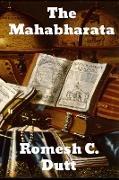- Start
- Mahabharata: The Epic of Ancient India
Mahabharata: The Epic of Ancient India
Angebote / Angebote:
The Mahabharata is one of the two major Sanskrit epics of ancient India, the other being the Ramayana. Besides its epic narrative of the Kurukshetra War and the fates of the Kaurava and the Pandava princes, the Mahabharata contains philosophical and devotional material, such as a discussion of the four "goals of life" or purusharthas. Among the principal works and stories in the Mahabharata are the Bhagavad Gita, the story of Damayanti, an abbreviated version of the Ramayana, and the Rishyasringa, often considered as works in their own right. Traditionally, the authorship of the Mahabharata is attributed to Vyasa. There have been many attempts to unravel its historical growth and compositional layers.The oldest preserved parts of the text are thought to be not much older than around 400 BCE, though the origins of the epic probably fall between the 8th and 9th centuries BCE. The text probably reached its final form by the early Gupta period (4th century CE). According to the Mahabharata itself, the tale is extended from a shorter version of 24, 000 verses called simply Bharata. Research on the Mahabharata has put an enormous effort into recognizing and dating layers within the text. Some elements of the present Mahabharata can be traced back to Vedic times. The background to the Mahabharata suggests the origin of the epic occurs "after the very early Vedic period" and before "the first Indian 'empire' was to rise in the third century B.C." That this is "a date not too far removed from the 8th or 9th century B.C." is likely. Mahabharata started as an orally-transmitted tale of the charioteer bards. It is generally agreed that "Unlike the Vedas, which have to be preserved letter-perfect, the epic was a popular work whose reciters would inevitably conform to changes in language and style, so the earliest 'surviving' components of this dynamic text are believed to be no older than the earliest 'external' references we have to the epic, which may include an allusion in Panini's 4th century BCE grammar 4:2:56. It is estimated that the Sanskrit text probably reached something of a "final form" by the early Gupta period (about the 4th century CE). Vishnu Sukthankar, editor of the first great critical edition of the Mahabharata, commented: "It is useless to think of reconstructing a fluid text in a literally original shape, on the basis of an archetype and a stemma codicum. What then is possible? Our objective can only be to reconstruct the oldest form of the text which it is possible to reach on the basis of the manuscript material available.
Fremdlagertitel. Lieferzeit unbestimmt
